
During the month of May, children crown statues of the Madonna with wreaths of flowers and Mary gardens begin to bloom, for in the Church, May is Mary’s month. Although the tradition of associating the month of May with the Mother of our Lord did not take place until the sixteenth or seventeenth century, the Holy Virgin has been associated with flowers, gardens, and Paradise itself since the Patristic period.
In the seventh century, Saint Fiacra of Ireland planted the first Mary garden which was a garden around the oratory of Our Lady. The medievals assigned many flowers Marian names and commonly portrayed Mary amidst an enclosed garden. During the early 20th century, Mary gardens grew in popularity and recently have started to make a comeback. Why this association of Mary with flowers and springtime?
Saint John Henry Newman explains well the reasoning for the association:
The first reason is because it is the time when the earth bursts forth into its fresh foliage and its green grass after the stern frost and snow of winter and the raw atmosphere and the wild wind and rain of the early spring. It is because the blossoms are upon the trees and the flowers are in the gardens. It is because the days have got long, and the sun rises early and sets late. For such gladness and joyousness of external Nature is a fit attendant on our devotion to her who is the Mystical Rose and the House of Gold.1
Mary is the Mother of Sorrows but also of the Mother of Joy. During the Easter season, which often coincides with the month of May, we remember her great joy in the Resurrection of her son.
As Gerard Manly Hopkins Hopkins wrote in his poem May Magnificat,
All things rising, all things sizing
Mary sees, sympathising
With that world of good,
Nature's motherhood.Their magnifying of each its kind
With delight calls to mind
How she did in her stored
Magnify the Lord.2
According to Hopkins’ verse, Mary is not an earth goddess, who stands above creation; rather, she is part of creation and sympathizes with nature’s springtime exuberance, reminding us that all creation is made to sing of God’s glory.

Church Fathers referred to the Holy Virgin as Paradise because of how she made a home for Christ in her womb and in her house. Her soul became a garden in which she allowed the virtues to flower. In a hymn, the poet Conrad of Wurzburg (1220-1287) called Mary “a living Paradise filled with noble flowers.”
Related to this is the idea that Mary is the Hortus Conclusus, the enclosed garden, which draws on the garden from Genesis as well as the Song of Solomon: “A Garden locked is my sister, my bride, a garden locked, a fountain sealed” (Song of Solomon 4:12). The enclosed garden is symbolic of her virginity and an image of Paradise.3
Artistic representations of the Madonna in the Hortus Conclusus were especially popular in the Gothic period. This theme is not common in art after the Renaissance, but there are exceptions. See Maurice Denis’s painting below.
One of my favorite images of the Hortus Conclusus is the Paradise Garden by the Upper Rhenish Master (below). The painting is so joyful and charming, full of life and conviviality. The walled garden brims with flowers and trees. Mary and the saints around her employ themselves in perfect leisure. They behold creation and the Word of God by playing instruments, reading the Bible, picking fruit, etc.
By leisure I do not mean mere idleness, but the “mental and spiritual attitude”, Josef Pieper writes about in Leisure the Basis of Culture:
Leisure is a form of silence, of that silence which is the prerequisite of the apprehension of reality: only the silent hear and those who do not remain silent do not hear….
For leisure is a receptive attitude of mind, a contemplative attitude, and it is not only the occasion but also the capacity for steeping oneself in the whole of creation….
In leisure, man too celebrates the end of his work by allowing his inner eye to dwell for a while upon the reality of the Creation. He looks and he affirms: it is good…4
In this image, Mary, in her humility, sits upon a red cushion, contemplating the Word. A gold diadem rests on her head, and a stone table with the Eucharistic chalice laid upon it stands beside her. In the corner of the painting, Saint Barbara holds her dipper in a well, an image which points to the waters of Baptism as well as a story in which Saint Barbara’s bones restore water in a desert.5 The well is also an image from the Song of Solomon that has been interpreted as a Marian image.
All of the saints are in harmony with the divine melody the Christ child plays on the psaltery, a medieval instrument. Saint Barbara picks cherries from the cherry tree while Saint George and Saint Oswald converse with an Angel. The dead dragon lies at their feet, and they can behold each other without worrying about what lurks around the corner. A dark brown monkey, perhaps the devil, is chained to a stump at their feet.
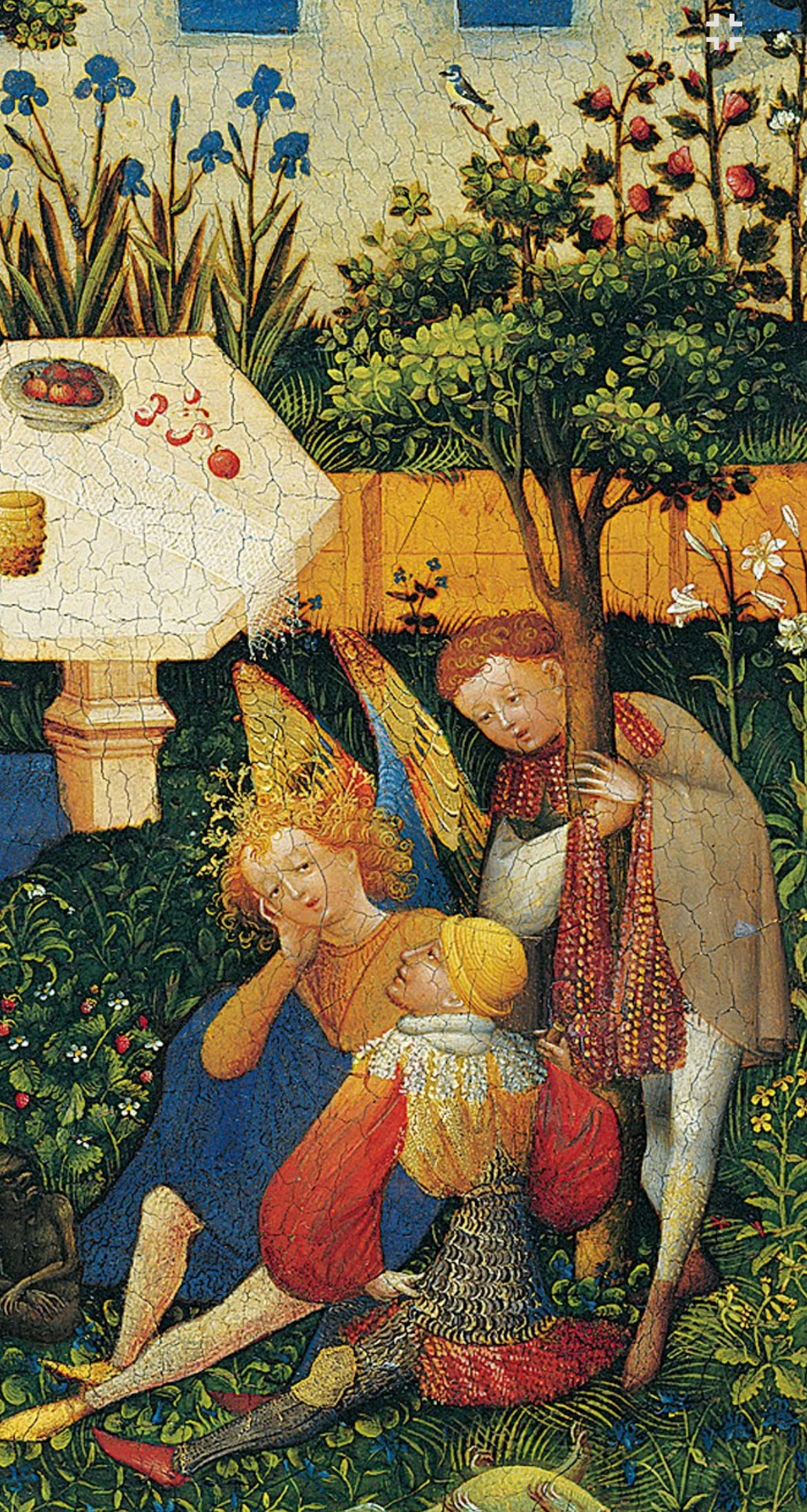
The image brings to mind memories of a perfect springtime day, as spring is the season that gives us a taste of the abundance of heaven. Of course, this is not really an image of spring; it is an image of Paradise, where there are no shadows and all fruit and flowers grow at once.
The image perfectly portrays the abundance of Paradise. According to the Stadel Museum website, there are 24 identifiable plant species and 12 bird species in the small painting.6 This reflects the Gothic interest in detailed representation of flora and fauna. The medievals assigned great symbolic value to even the smallest aspects of creation, following St Basil’s maxim from the Hexameron:
Therefore, when you see the trees in our gardens, or those of the forest, those which love the water or the land, those which bear flowers, or those which do not flower, I should like to see you recognizing grandeur even in small objects, adding incessantly to your admiration of, and redoubling your love for the Creator.7
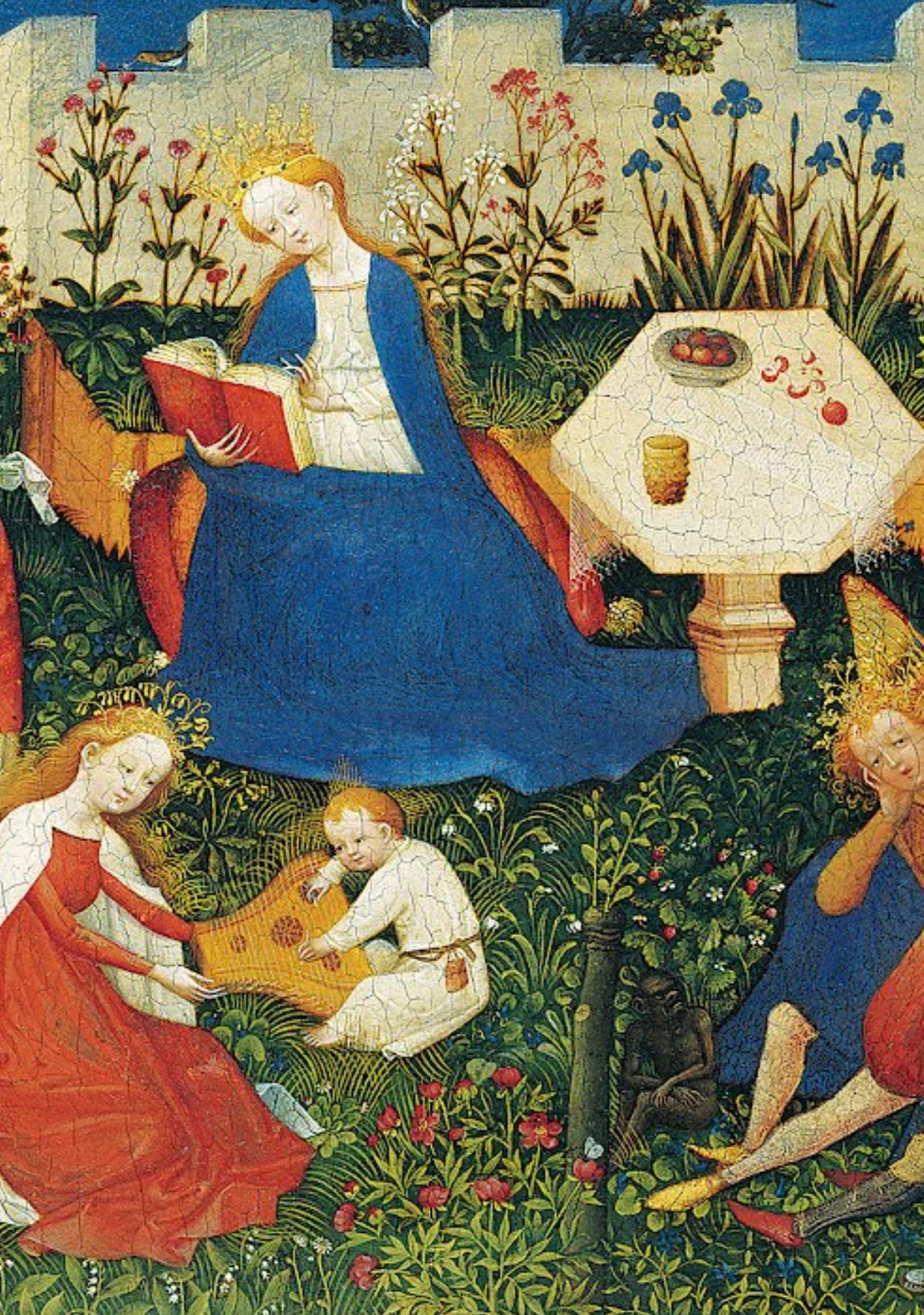
Every flower in the image is symbolic of some Marian virtue. Saint Bernard names a few pictured here: "The rose of charity, the lily of chastity, the violet of humility and the golden gillyflower of heaven.”8
Others flowers depicted include:
Cherries: purity, sweetness
Lilies of the valley: Mary’s tears
Irises: the swords that pierced Mary’s heart
Forget-me-knots: Mary’s eyes
Daisies: Mary’s star
Lillies: purity
Strawberries: Mary’s fruitful virginity
Primroses: key to heaven
Here, the walled garden is many things: the Hortus Conclusus, the garden from Genesis, as well as Paradise restored, the New Jerusalem. It is the place where Christ, through his Incarnation, restores harmony in creation. It is a place of safety, serenity, fecundity, harmony and intimacy.
St. John Henry Newman beautifully illuminates the spiritual meaning of the garden in these paintings:
Scripture makes use of the figure of a garden, when it would speak of heaven and its blessed inhabitants. A garden is a spot of ground set apart for trees and plants, all good, all various, for things that are sweet to the taste or fragrant in scent, or beautiful to look upon, or useful for nourishment; and accordingly in its spiritual sense it means the home of blessed spirits and holy souls dwelling there together, souls with both the flowers and the fruits upon them, which by the careful husbandry of God they have come to bear, flowers and fruits of grace, flowers more beautiful and more fragrant than those of any garden, fruits more delicious and exquisite than can be matured by earthly husbandman.9
Thus, the garden is an image of the Church as well as of Mary. Mary holds Christ in her womb as the Church gathers us within her walls, providing us a place to encounter Christ through the sacraments, in communion with the saints.
These paintings, along with Mary gardens and the like, can help us to appreciate the spiritual meaning of spring, and with Hopkins see how:
This ecstasy all through mothering earth
Tells Mary her mirth till Christ's birth
To remember and exultation
In God who was her salvation.10
Over Mother’s Day weekend, my husband started working on a Mary garden in our backyard. So far we have impatiens, Mary’s love), marigolds, roses, snapdragons (Infant Jesus’s shoes), and mandevilla. It has been raining a lot lately so we haven’t put the rocks over the weed barrier yet. We’re still looking for a Mary statue.
It’s a work in progress, but that’s the fun of gardening.
https://www.newmanreader.org/works/meditations/meditations1.html
https://www.thereader.org.uk/featured-poem-may-magnificat-by-gerard-manley-hopkins/
https://substack.com/home/post/p-117106911?utm_campaign=post&utm_medium=web
Josef Pieper, Leisure the Basis of Culture, p. 46-49.
Some scholars believe this is Saint Anne.
https://sammlung.staedelmuseum.de/en/work/the-little-garden-of-paradise
https://www.fisheaters.com/marygardens.html
https://udayton.edu/marianlibrary/marysgardens/m/mary-garden-design-philosphy.php
https://www.newmanreader.org/works/meditations/meditations1.html
Full poem:
May Magnificat
May is Mary's month, and I
Muse at that and wonder why:
Her feasts follow reason,
Dated due to season—
Candlemas, Lady Day;
But the Lady Month, May,
Why fasten that upon her,
With a feasting in her honour?
Is it only its being brighter
Than the most are must delight her?
Is it opportunest
And flowers finds soonest?
Ask of her, the mighty mother:
Her reply puts this other Question:
What is Spring?—
Growth in every thing—
Flesh and fleece, fur and feather,
Grass and greenworld all together;
Star-eyed strawberry-breasted
Throstle above her nested
Cluster of bugle blue eggs thin
Forms and warms the life within;
And bird and blossom swell
In sod or sheath or shell.
All things rising, all things sizing
Mary sees, sympathising
With that world of good,
Nature's motherhood.
Their magnifying of each its kind
With delight calls to mind
How she did in her stored
Magnify the Lord.
Well but there was more than this:
Spring's universal bliss
Much, had much to say
To offering Mary May.
When drop-of-blood-and-foam-dapple
Bloom lights the orchard-apple
And thicket and thorp are merry
With silver-surfed cherry
And azuring-over greybell makes
Wood banks and brakes wash wet like lakes
And magic cuckoocall
Caps, clears, and clinches all—
This ecstasy all through mothering earth
Tells Mary her mirth till Christ's birth
To remember and exultation
In God who was her salvation.
Gerard Manley Hopkins




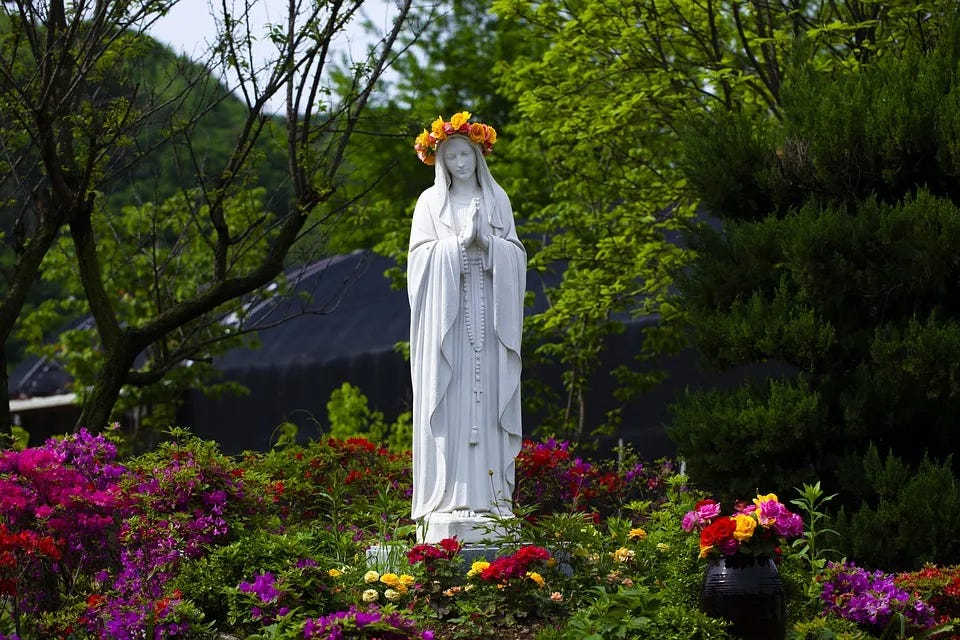
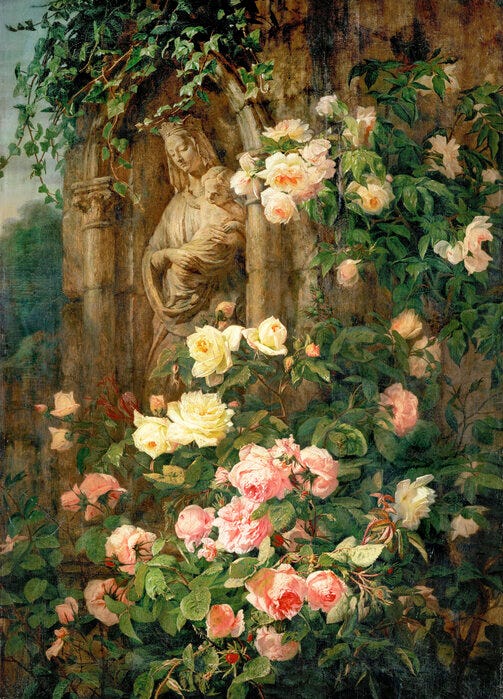
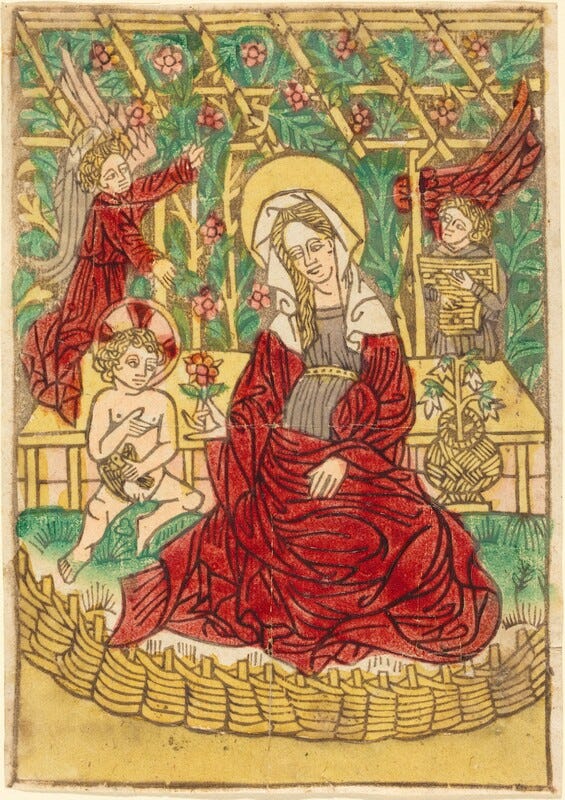

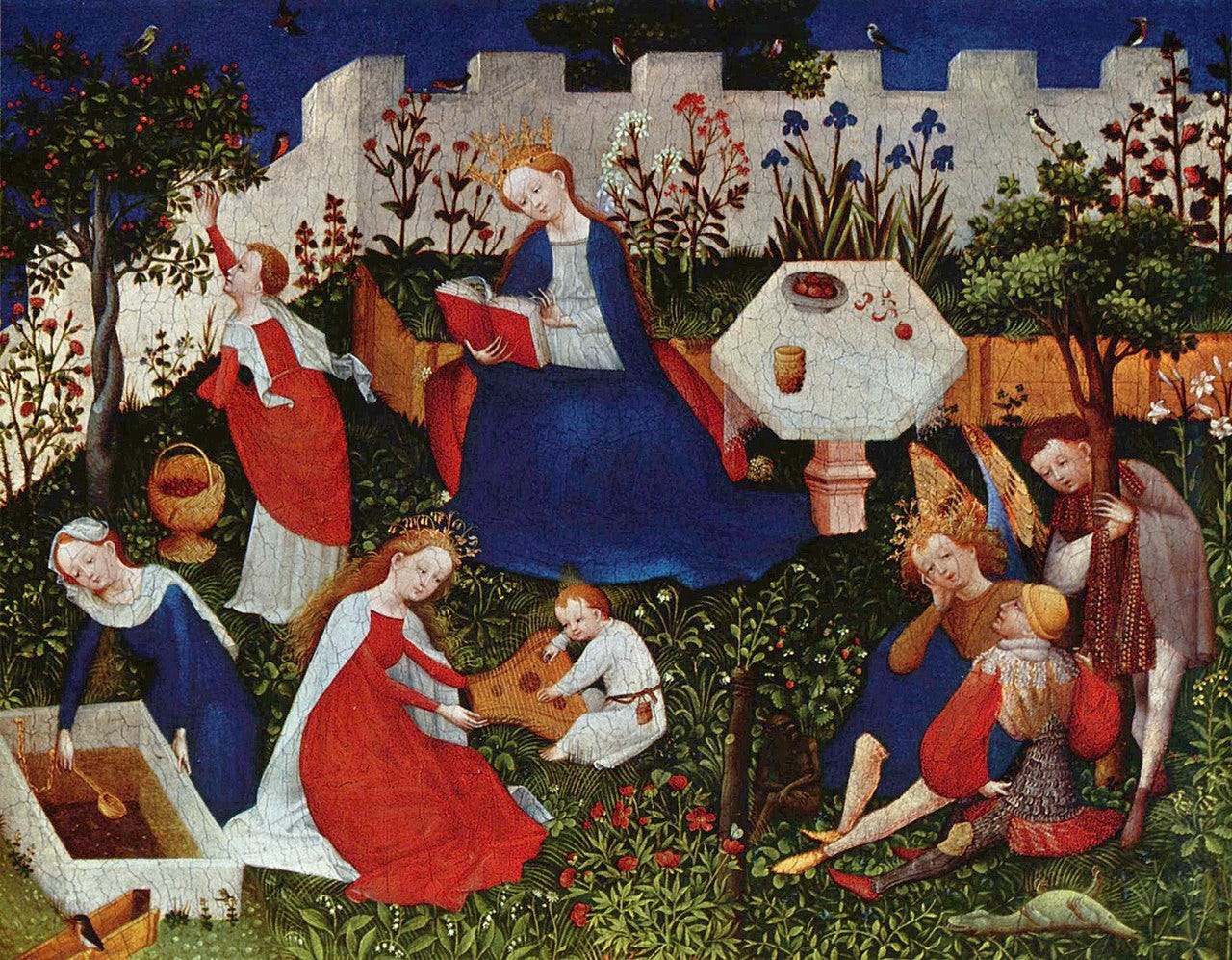


Most Holy Theotokos save us! 🔔🌐☦️🕊️🌹⛪
Beautiful essay and art. Coincidentally, this very morning I was labeling captions for three medieval "Hortus Conclusus" Annunications in which Mary is in a walled garden and a unicorn is in her lap (the unicorn was a symbol for the Christ in the High and Late Middle Ages). My essay is on unicorns in medieval thought, though, so I was ignoring the garden symbolism itself -- it's nice to see you expound on it.